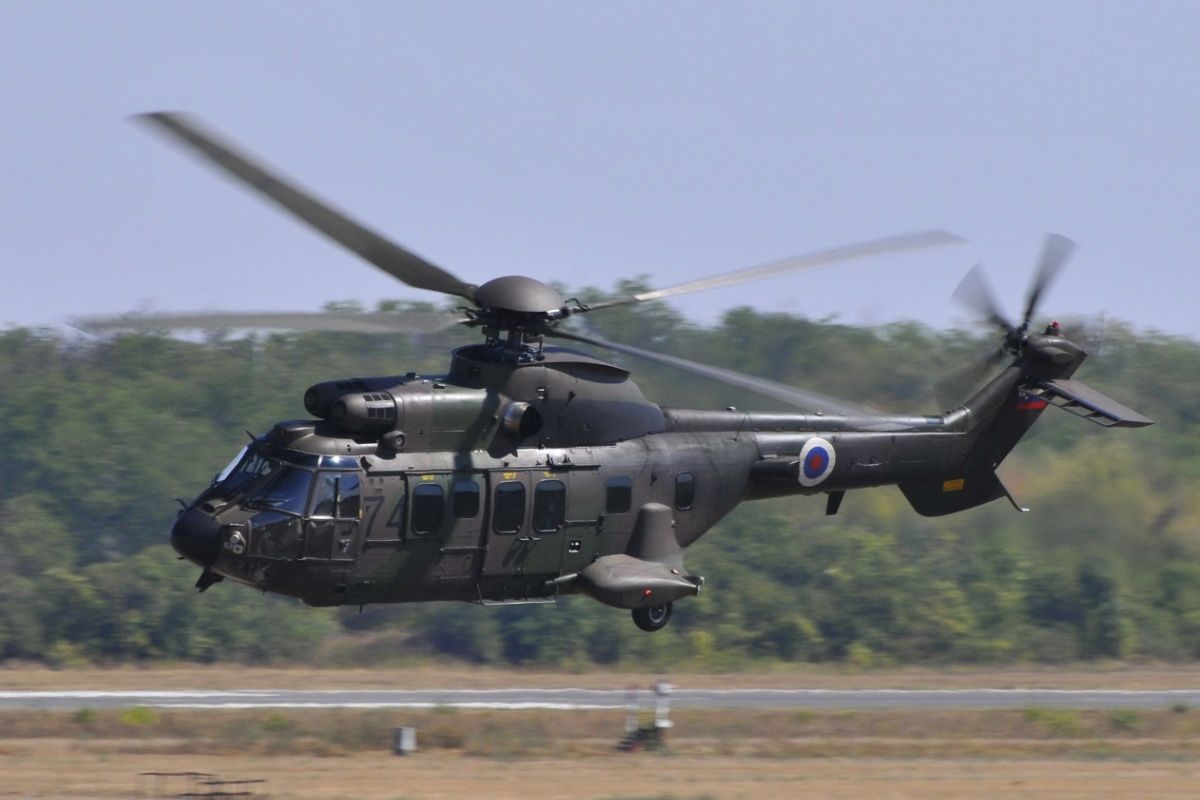Summary The Airbus H225M, a long-range tactical transport helicopter, supports missions like troop transport and combat search and rescue. The H215 variant offers multirole capabilities and payload flexibility, with one version focusing on utility and firefighting missions. Airbus Helicopters have found success with the military H225M variant, boasting reliability and versatility in various challenging environments.
The Eurocopter EC225 Super Puma (now called the Airbus Helicopters H225) is a long-range passenger transport helicopter and the next generation of the civilian Super Puma family developed by the French aerospace company Aerospatiale. Built in the 1970s, the Super Pumas have found a wide range of roles worldwide, both military and civilian. These are now built by Airbus' large helicopter division and have military and civilian-focused variants.

Original Eurocopter AS332 Puma family The origins of the Super Puma family trace back to 1962 when the French military announced the requirement for a twin-engine tactical transport helicopter that could operate in all weather conditions. Development work started in 1963 (with the designation SA300). In 1967, the aircraft was selected as part of an Anglo-French helicopter agreement (Sud Aviation and Westland Helicopters shared production).
The Puma later entered service in both the Royal Air Force and the French Army Air Force, with production running until 1982, by which time 679 had been produced. Airbus Civil Helicopters: Airbus Military Helicopters: H125 Intermediate single engine H125M Light H130 Intermediate single engine Military Training H135 Light twin engine H135 Light twin engine H145M Light twin engine H145 Light twin engine H160M Medium twin engine H160 Medium twin engine H175M Super-medium H175 Super medium twin engine H215M Heavy twin engine H215 Heavy twin engine H225M Heavy twin engine H225 Heavy twin engine Tiger Specialised twin engine NH90 (TTH and NFH) Specialised twin engine Aerospatiale succeeded Sud Aviation in 1970 and soon worked on a new version of the Puma that would go on to be the Super Puma. Aerospatiale later merged with Airbus in 2000, leading to the renaming of the helicopters.
Today, Airbus' two heavy twin-engine helicopters - the H215/H215M and H225/H225M are derived from Aerospatiale's AS332 Super Puma. The company said the new technologies bring the “future of flight a step closer.” Airbus Helicopters H215 variants The Super Puma is a re-engined and more voluminous version of the original Aérospatiale SA 330 Puma.
The Super Puma family of helicopters first flew in 1978, while the Eurocopter EC225 first flew in 2000. These provide long-range passenger transport capabilities. Depending on the configuration, they are able to carry up to 24 passengers (including two crew and a cabin attendant).
They are used for offshore support and VIP transport (among other missions). While the helicopter is built with a civilian focus, it has a military counterpart - the Eurocopter EC725 (rebranded in 2015 as the HM225M ). Airbus Helicopters H215 H215 variants: long & short Capacity: 19 passengers / 22 troops Useful load long version: 3,889 kg / 8,575 lbs Useful load short version: 4,038 kg / 8,900 lbs Powerplant: 2x Safran Helicopter Makila 1A1 Turboshaft The H215 variant is available in two different versions—one tailored for multirole operations and the other with a shorter cabin airframe and increased payload capacity.
The multi-role version boasts a large reconfigurable cabin and can fulfill a full spectrum of public service missions (SAR, medevac, law enforcement, passenger transport, firefighting, disaster relief, etc.). The shorter airframe version allows for a lighter configuration increasing its payload capacity so that it is better suited for aerial work and firefighting missions.
It can be configured for utility and passenger transport. It offers great payload lift performance and cost efficiency and is designed to operate in some of the world's harshest environments. The British offshore transport operator, Bristow Helicopters became the largest operator of the Super Puma after it ordered some 35 helicopters (a variant called the Bristow Tiger).
One example of use is transporting North Sea oil workers to and from the Brae Alpha oil and gas fields, some 155 miles off the coast of Scotland. The manufacturer calls it “one of Airbus Helicopters' most exciting innovation projects.” Military Eurocopter EC725 Caracal / Airbus Helicopters H225M variant The now-named Airbus Helicopters H225M is a long-range military tactical transport helicopter.
The twin-engined helicopter is able to carry up to 28 troops (depending on configuration) and is used for troop transport, combat search and rescue, and casualty evacuation. It comes with two large sliding cargo double doors and two large sliding windows for machine gun installation. "As the most advanced member of Airbus’ military Super Puma/Cougar family, the 11-metric-tonne H225M has proven its reliability and durability in combat conditions and crisis areas that include Lebanon, Afghanistan, Chad, the Ivory Coast, the Central African Republic, Somalia, and Mali, while also supporting NATO-led operations in Libya.
" - Airbus Military Airbus Helicopters H225M variant Introduction: 2005 Number produced: over 90 Range: 700 nautical miles Role: Special operations, Combat search and rescue, Tactical transport, Casualty / medical evacuation Powerplant: 2x Makila 2A1 turboshaft engines Operators: France, Brazil, Mexico, Malaysia, Indonesia, Kuwait, Singapore, Hungary, Thailand The H225M is intended to be a versatile and reliable workhorse for the military that combines fast cruise speed, long range, and in-flight agility. Its maximum external load sling capacity is 4,750 kg or around 10,500 lbs. So far it has been purchased by the militaries of France, Brazil, Mexico, Malaysia, Indonesia, Kuwait, Singapore, Hungary, and Thailand.
Airbus' H225M is able to operate from ships and land (even in icing conditions). It is built as an all-weather helicopter supported by night vision goggle compatibility..



















